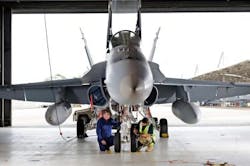A team of researchers at RMIT University (Melbourne, Australia) is using laser metal deposition technology (a 3D printing technique) to build and repair defense aircraft parts in a two-year collaboration with RUAG Australia (Bayswater, Australia) and the Innovative Manufacturing Cooperative Research Centre (IMCRC; Carlton, Australia).
Related: Lockheed Martin, RMIT University form additive manufacturing partnership
Laser metal deposition technology feeds metal powder into a laser beam, which when scanned across a surface adds new material in a precise, web-like formation. The metallurgical bond created has mechanical properties similar, or in some cases superior, to those of the original material. "It's basically a very high-tech welding process where we make or rebuild metal parts layer by layer," explains Professor Milan Brandt, who is leading the work. He says the concept is proven and prospects for its successful development are extremely positive.
By enabling onsite repair and production of parts, the technology could completely transform the concept of warehousing and transporting for defense and other industries, says Neil Matthews, Head of Research and Technology at RUAG Australia. Currently, replacement parts typically need to be transported from local or overseas storage and suppliers.
"Instead of waiting for spare parts to arrive from a warehouse, an effective solution will now be on-site," Matthews says. "For defense forces, this means less downtime for repairs and a dramatic increase in the availability and readiness of aircraft."
The technology will apply to existing legacy aircraft as well as the new F35 fleet. The technology is also being adopted in RUAG's recently established robotic laser additive manufacturing cell.
"The project's benefits to Australian industry are significant. Although the current project focuses on military aircraft, it is potentially transferable to civil aircraft, marine, rail, mining, oil, and gas industries," says David Chuter, CEO and managing director of the IMCRC. "In fact, this could potentially be applied in any industry where metal degradation or remanufacture of parts is an issue."
Sponsored Recommendations
Sponsored Recommendations
Request a free Micro 3D Printed sample part
April 11, 2024
How to Tune Servo Systems: The Basics
April 10, 2024
Voice your opinion!
Voice your opinion!
